How to Read Prescription Drug Labels Prescription Number Mean
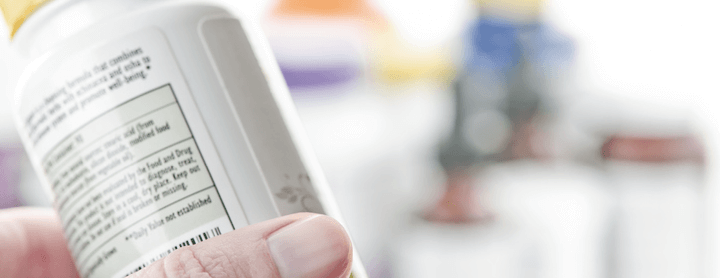
Consumers should ever read drug labels to make sure they are taking a medication correctly and safely as well every bit to acquire about possible side furnishings. Unfortunately, these labels can be challenging for the boilerplate person to understand.
If you struggle to brand sense of the information on your drug labels, you are not lone.
"Several studies accept shown that patients oftentimes have difficulty in reading and agreement medication labels, which may lead to medication errors such as taking the wrong medication or the incorrect dose," said Mireille Hobeika, who received her doctorate in pharmacy from the University of Saint Joseph in West Hartford, Connecticut.
Agreement drug labels is even more important for people with chronic illnesses and seniors. They take the greatest run a risk of medication errors or interactions because they tend to accept multiple medications.
There are 2 kinds of drug labels: over-the counter drug labels — as well called Drug Facts — and prescription drug labels, which include many pages of safety data, such every bit pharmacy information sheets, medication guides and prescribing information.
Before you showtime taking a new medication, review the drug label with your physician and chemist and let them know of whatsoever health conditions you have and any medications and supplements you take.
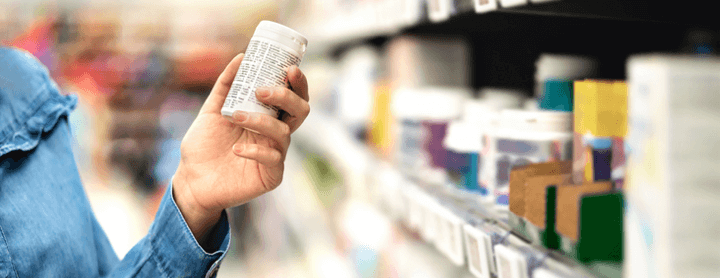
Over-the-Counter Drug Facts
Over-the-counter, or OTC, drugs are medications that don't require a prescription. Manufacturers print drug labels called Drug Facts directly on OTC drug production packages.
Whatsoever product with a substance intended for diagnosis, cure, treatment, prevention or mitigation of a disease is a drug, according to the Nutrient and Drug Administration — including products like fluoride toothpaste and antidandruff shampoo. If y'all are unsure whether a product is an OTC drug, check the packaging for a Drug Facts label.

Expand
Over-the-counter products such equally fluoride toothpaste include drug labels on their packaging.
4 out of five American adults commonly take OTC drugs, according to a 2018 article by Stefanie Ferreri, PharmD, BCACP, a clinical professor at the University of North Carolina Eshelman School of Chemist's shop in Chapel Hill.
In 2016, the well-nigh popular OTC drugs included pain relievers, heartburn drugs such as Prilosec and Nexium, upper respiratory drugs and toothpaste, Ferreri said in her commodity, which was published by Pharmacy Times.
Information on OTC Drug Labels
In 1999, the FDA created a regulation to simplify and standardize the Drug Facts label. It required most OTC drugs to follow the new format and content requirements past May 2002.
These labels are short and simple and typically have 6 main parts, Hobeika said. Some labels include a seventh section with a phone number to call if you lot accept questions or comments.
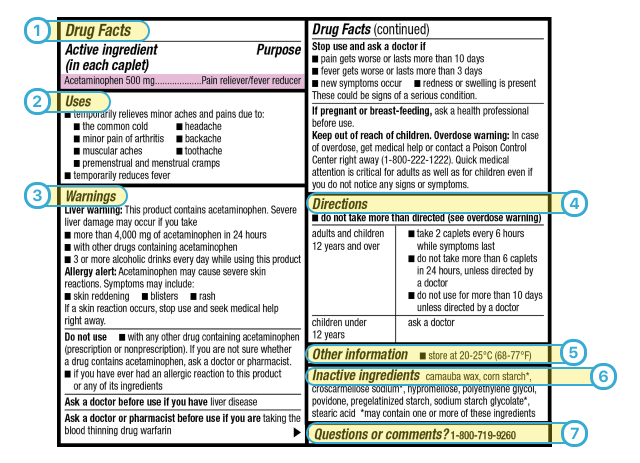
EXPAND
The Drug Facts characterization for the over-the-counter drug acetaminophen, known past the brand name Tylenol, includes information about ingredients, uses, warnings and directions.
- Agile Ingredient and Purpose. This section lists the ingredient that makes the drug work. It also lists what the active ingredient does and how much of information technology is in each medication dose. In this example, the drug contains 500 mg of acetaminophen per caplet, and its purpose is to relieve pain and reduce fever. "It is very of import to check [this data] to understand what will be the effect of the drug and to avoid taking other drugs with the aforementioned ingredients by mistake," Hobeika said.
- Uses. This section tells you what symptoms and conditions the drug can treat. It'due south important to brand sure you are using the right drug for your symptoms.
- Warnings. This section is typically the longest department of the Drug Facts label. It tells you nigh any severe side furnishings or drug interactions that can occur and describes who should non utilise the drug. It tells you when to stop using the drug and when to consult your medico and/or chemist.
- Directions. This department of the label tells you when, how and how ofttimes to take the drug. Go along in mind that children may have different instructions from adults. "Do non take more than what the label says before asking your physician," Hobeika said. "Taking a higher dose than what it is recommended on the drug label can exist dangerous."
- Other Information. This department tells you how to store the drug. Some drugs may exist sensitive to oestrus or moisture.
- Inactive Ingredients. In addition to the active ingredient that makes the drug work, medications as well have ingredients such every bit dyes, preservatives and flavoring agents. "Information technology is important to check this information to help avoid ingredients that may cause an allergic reaction," Hobeika said.
- Questions or Comments. This department includes contact data available to consumers with questions about the production. It may not exist on all Drug Facts labels.
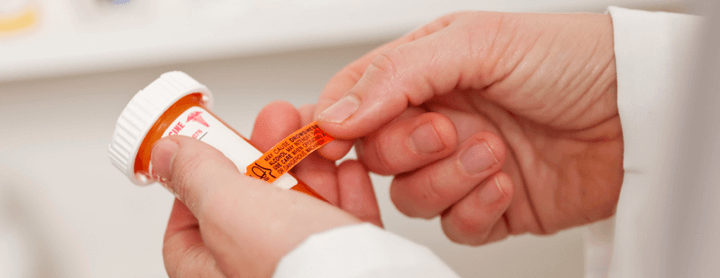
Prescription Drug Labels
Prescription drug labels are more complicated than OTC drug labels. More than than half a million Americans misinterpret prescription drug labels each year, according to Consumer Reports.
The FDA doesn't regulate the labels from pharmacies. Alert information printed or placed on the bottle equally stickers may vary depending on the pharmacy.
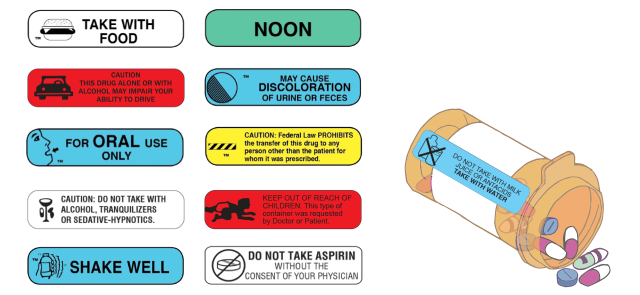
Expand
Prescription labels may contain warning stickers.
For instance, Consumer Reports staffers filled prescriptions for warfarin at unlike pharmacies and found that packaging from Target, Walgreens, CVS, Costco and Walmart included dissimilar numbers of warnings for the same prescription. Walmart didn't include any alarm on the showtime attempt to make full the prescription.
"Labeling tin can be confusing, vague, misleading, hidden in medical jargon or missing altogether," said Rachel Brummert, a patient advocate and FDA special employee. "If prescription labeling were consistent, we could avoid many of the problems acquired by inconsistent labeling."
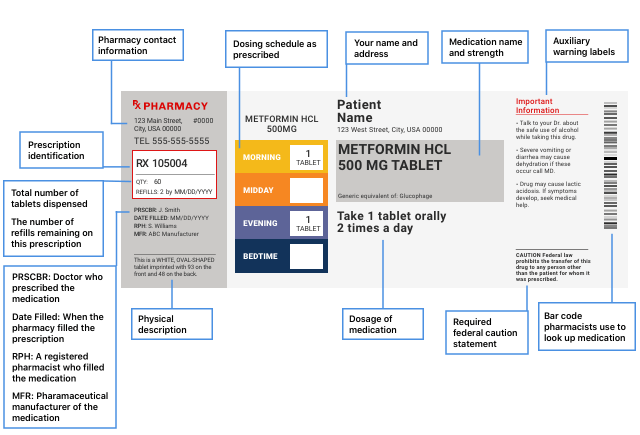
Expand
Drug labeling can vary depending on the pharmacy.
Pharmacy Information Sheets
The drug characterization printed on prescription drug packaging doesn't tell you all the safety information for the drug, and then pharmacies will give y'all a pharmacy data sheet. On this sheet, look for warnings or cautions, drug uses, how to use the drug, side effects, precautions, drug interactions, overdose data and how to shop the drug.
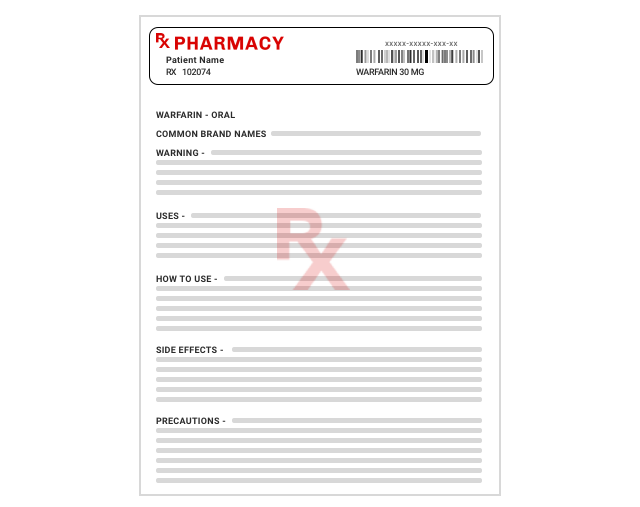
Pharmacy information sheets accept bones use, alarm and side consequence data but tin can be incomplete.
Still, the pharmacy data sail may not be consummate, said Dr. Michael Carome, director of Public Citizen's Health Inquiry Group.
"Lots of [prescription] drugs have pharmacy information sheets, and often … those data sheets accept not been reviewed past the FDA," Carome said. "And the information may not be as authentic in terms of things to scout out for."
When Consumer Reports filled prescriptions for warfarin it found "incomplete or hard-to-read parcel inserts — and in four of v cases, a dangerous omission that violated an FDA regulation."
Carome recommends finding the official FDA-approved prescribing information online on the drug manufacturer's website or on DailyMed, a site administered by the National Institutes of Health.
Prescribing Information
According to the FDA, the approved prescribing information — likewise called the package insert — is the actual prescription drug characterization. The prescribing information is several pages long, and it's intended to help providers properly prescribe the medication.
Other names for this data include professional labeling, package insert and prescribing data. The FDA updates this information regularly on DailyMed.
FDA Requirements for Prescription Drug Labeling
- Is based on human being data when possible
- Is accurate and informative
- Is a summary for the constructive and safe utilise of the drug
- Does not brand claims or propose uses if show is lacking
- Is non false, misleading or promotional
Prescribing information tin can be more than complicated to read, just it includes more detailed safety information than the chemist's drug label or data sheet. Plus the FDA has reviewed information technology for accurateness unlike information provided to you by the pharmacy. If you have trouble interpreting prescribing information, your medico or pharmacist might be able to help you better understand important information.
In 2006, the FDA issued a concluding rule that changed the format of product labels to make it easier for health intendance professionals.
"The label is now divided into highlights of prescribing information, contents of the full prescribing data (FPI) and the FPI," Hobeika said. "The highlights department is a half-folio summary of the information that health care practitioners most unremarkably refer to and consider as nearly of import."
Highlights of Prescribing Information
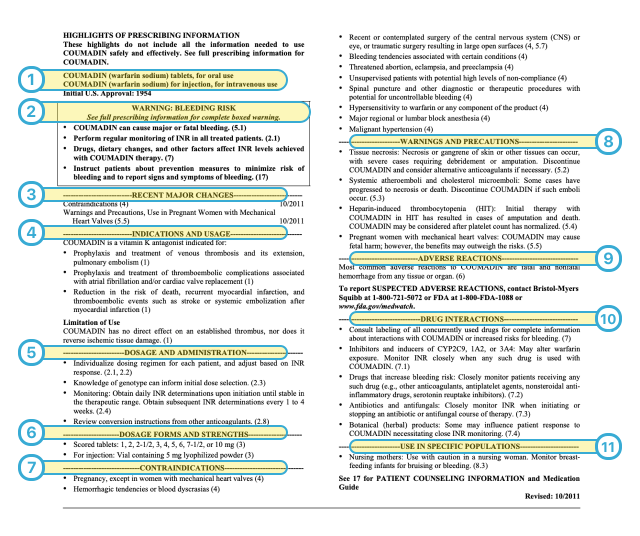
Expand
The Highlights of Prescribing Information for Coumadin, the brand proper noun of warfarin, provides health care practitioners with a one-half-page summary of the virtually commonly referred to safety information.
- Name of Drug. The very first section will tell y'all the proper name of the drug. It will show you the make name as well as the generic proper noun, or active ingredient, in parentheses. This department besides tells you what formulation it is (injection, oral, etc.) and the twelvemonth the FDA approved the drug.
- Black Box Warning. If in that location is a black box alarm for the drug, information technology will be at the top of the page. The boxed warning provides the most important prophylactic information about the drug. In the case of Coumadin, it warns about the chance of major or fatal bleeding.
- Contempo Major Changes. Beneath the black box alarm, you will find any recent major changes to the prescribing information and the date they were fabricated. The FDA will add or remove warnings. If y'all take been taking the aforementioned medication for a while, it is a good idea to cheque this section periodically to encounter if at that place have been new warnings added. Yet, this section is non e'er included.
- Indications and Usage. This section lists all of the conditions the FDA has canonical the drug to treat. Sometimes wellness care providers can legally prescribe drugs for off-characterization uses, which are uses not approved by the FDA. Such uses might not be supported past data that proves safety or effectiveness, yet. All information in the prescribing data is specifically for FDA-approved uses only.
- Dosage and Administration. Here you tin can find information about the recommended corporeality of the drug and how to give it to a patient. For example, the Coumadin dose depends on tests a health intendance provider runs, and it is specific to the patient.
- Dosage Forms and Strengths. All of the unlike doses available from the manufacturer are listed here. Providers tin recommend whatever dose and may increase or decrease the dose over fourth dimension. Coumadin starts at 1 mg and goes up to 10 mg in its pill class, and the drug for injection comes in a vial containing 5 mg of pulverisation. Check the characterization on your prescription package from the pharmacy for the dose that your provider has prescribed for you.
- Contraindications. Not all medications are safe for everyone. This section tells providers who should not have the drug.
- Warnings and Precautions. Warnings and precautions inform doctors well-nigh serious conditions that can occur in people taking the drug. It alerts them to health issues to picket for in their patients who have the drug. For example, people taking Coumadin might endure rare tissue expiry or gangrene that may lead to amputation.
- Adverse Reactions. Look here for the most mutual side furnishings suffered by people taking the drug. Coumadin's about common reactions are fatal and nonfatal bleeding. This department also provides contact information to report side furnishings to the manufacturer and the FDA.
- Drug Interactions. Drugs listed in this department may interact with the medication, increasing or decreasing its effectiveness or causing more side furnishings.
- Employ in Specific Populations. The drug may affect people differently depending on characteristics such as age, gender, race, pregnancy or the presence of kidney or liver damage. This section warns about safety or effectiveness concerns in these groups.
Full Prescribing Data
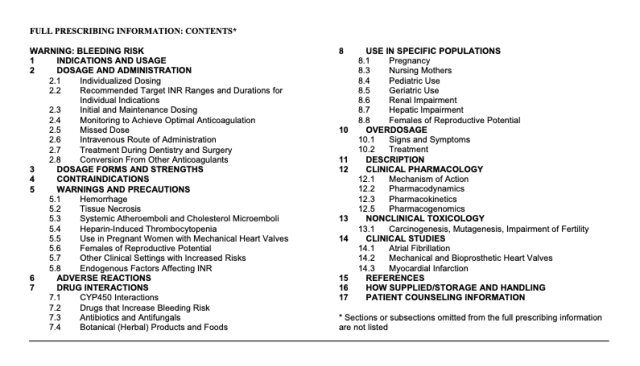
Expand
The total prescribing information is written for people in the medical community and elaborates on data found in the highlights section.
The total prescribing information expands on the information provided in the highlights section. This part of the prescribing data is the most complicated because manufacturers write it for wellness intendance providers, scientists and researchers, non patients.
In improver to the highlights, it contains information on how the drug works, how long it lasts in the body and how the body gets rid of the drug. It will also talk almost fauna studies, which might provide data nearly whether or not the drug causes cancer or infertility.
The manufacturers also share results of clinical trials, data showing how well the drug works and its side effects from those clinical trials.
Diana Zuckerman, president of the National Center for Wellness Research, recommends patients consider the following questions and tips when reading clinical trial data on drug labels.
- Were patients in the written report like you in terms of historic period, sex, race and other characteristics? Expect for at to the lowest degree thirty patients similar you in the study. It might non provide you the most relevant data if people in the study aren't like enough to you.
- Were patients in the study like you lot in terms of medical diagnosis? For example, if it'southward a cancer drug, did the study involve people with your type of cancer? The same goes for drugs that care for other diseases. Data might exist less relevant to you if you are non represented by patients in the study.
- Is the drug tested in people who failed at other treatments? The FDA approves some higher risk drugs for people with no other handling options.

Medication Guides
If a drug has an FDA-approved medication guide, pharmacists are supposed to give information technology to patients with their prescription, but this doesn't ever happen. And non all drugs accept them.
The FDA requires manufacturers to write medication guides in easy-to-understand linguistic communication for patients. You lot tin find these medication guides on the drug manufacturer's website or on DailyMed.
The blood thinner Coumadin, as well known under the generic name warfarin, has a medication guide. Similar to the Drug Facts on an OTC label, the medication guide tells patients the most important prescription drug information in simple linguistic communication.
Information in a Medication Guide
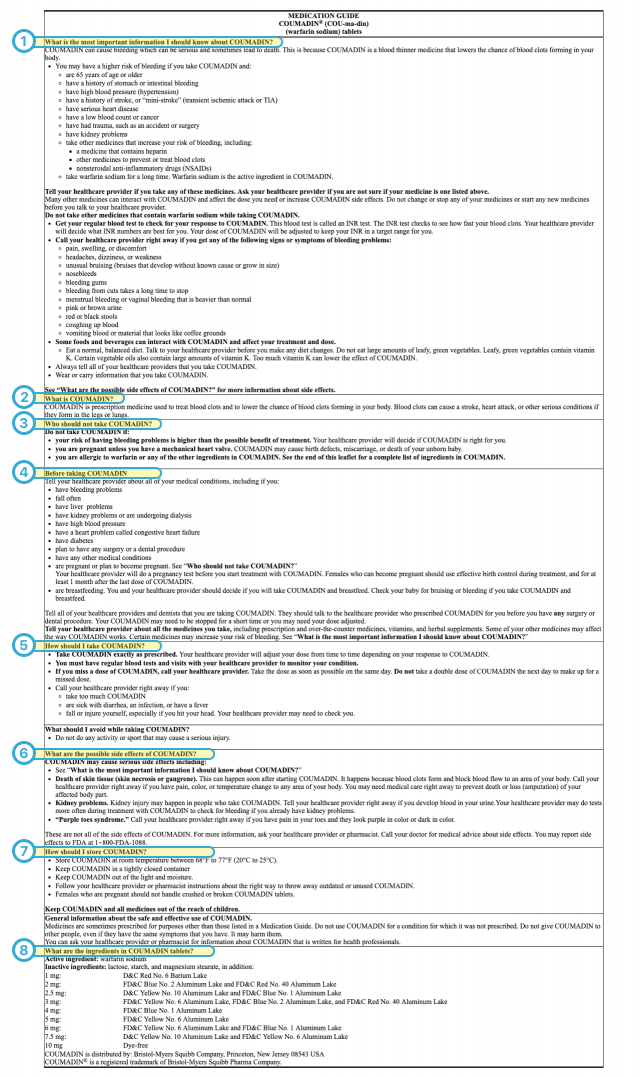
Expand
Manufacturers are required to write medication guides in language that'southward easy for patients to understand.
- What is the most of import information I should know nigh the drug? The virtually serious risks, side furnishings and symptoms you should look for are detailed hither.
- What is the drug? Here yous can find the status or symptoms the drug treats.
- Who should not accept the drug? This section describes diseases or health weather condition that may worsen with use of the drug. Information technology also addresses people who may be allergic to the drug.
- Before taking the drug. If yous have diseases or wellness conditions listed in this section, talk to your dr. before taking the medication.
- How should I take the drug? This section explains the special instructions on how to take the drug. It reminds people to take the drug simply as directed past their doctor.
- What are the possible side effects of the drug? This department includes side effects information and brief explanations almost each side effect. Sometimes information technology includes information on tests your provider may run or symptoms to watch for.
- How should I shop the drug? Information on how to store the drug is included here. Some drugs are sensitive to heat or cold and some may need refrigeration.
- What are the ingredients in the drug? Check this section for the active and inactive ingredients. Tell your provider if you are allergic to any ingredients in the drug.
Side Result Information
While serious side effects are rare, it'due south important that you seek the advice of a medical professional before making health care decisions. Learn about potential drug and device side effects.
Is Side Effect Information Always Accurate?
Side consequence data on drug labels ordinarily comes from clinical trial data collected before a manufacturer sells the drug. Sometimes the label volition get an update based on side upshot reports the FDA receives after the drug has been on the market place. This information is chosen postmarketing data.
"If side furnishings are known, they should always be included on the label, simply some side furnishings aren't known until years later a product goes on the market," Zuckerman said.
"If side effects are known, they should always exist included on the label, only some side effects aren't known until years afterward a product goes on the market."
Drug articles can face up lawsuits if they know about a side effect but neglect to warn consumers and doctors.
"Back when I took Levaquin in 2006, at that place were no black box warnings on fluoroquinolones," said Brummert, who suffered multiple ruptured tendons after taking the antibody. "The first warning came in 2008 for tendon ruptures, and that black box only stated that people over 60 were at risk. Agin reactions I have suffered that are still not included in the warnings are autonomic and key nervous system dysfunction and neurodegenerative disorders."
Brummert said she discovered the FDA had admitted to these side effects in a hidden document obtained through a Liberty of Information Act request.

What Should You Exercise If You Don't Understand a Label?
If you have tried reading a drug label and don't understand it, don't be afraid to inquire for help. Your health care providers, such as doctors and pharmacists, are there to assist you.
"Earlier leaving the doctors' office, patients should make sure they are well informed about the proper noun of the drug and why they are taking it, the medical conditions this drug treats, how many times per day should they take it, how long will it take this drug to work, when should they stop taking it, are there any side effects that they should know nearly and any situations where they should not be taking the drug," Hobeika said.
If you leave your health care provider'southward office without the information you lot need to take your medicine safely and effectively, the pharmacy from where you pick up your medication can help. Your chemist can respond questions about OTC and prescription medications.
Hobeika recommends having all prescriptions filled at the same pharmacy, so the pharmacist has a record of them. She also suggests doing the following earlier you lot go out the pharmacy:
- Bank check the label to brand sure your name is on it. If it isn't, talk to the pharmacist.
- Check the label to make sure you can read and sympathise the proper noun of the medicine, directions and colored alert stickers on the package. If the letters are too modest to read, inquire your pharmacist to print it in a larger blazon.
- Are the directions on the parcel the same every bit those y'all and your provider discussed? If not, tell the pharmacist.
- Inquire if there are special instructions on how to shop the medicine. Should it exist kept in the refrigerator or a dry out place?
- Ask if there is anything you shouldn't eat or drink while taking the medicine.
- Ask if it'southward safe to take the drug with other prescriptions or OTC medicines you're taking.
Source: https://www.drugwatch.com/health/how-to-read-a-drug-label/
0 Response to "How to Read Prescription Drug Labels Prescription Number Mean"
Post a Comment